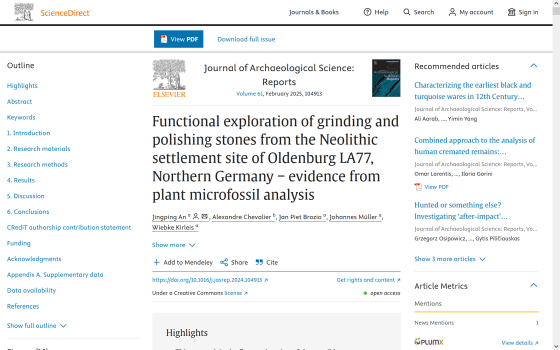How did farmers cook their grains 5,000 years ago?

In modern times, we eat a wide variety of food using various ingredients and seasonings, but the diet of the pre-Christian era, when not only food but even cooking utensils were scarce, is shrouded in mystery. Previous research has revealed that people who lived before the Common Era ate grains, but archaeologists are uncovering how they ate grains.
Functional exploration of grinding and polishing stones from the Neolithic settlement site of Oldenburg LA77, Northern Germany − evidence from plant microfossil analysis - ScienceDirect

Not only cereals: Revealing the menu of farmers 5,000 years ago
Jinping An and his colleagues from Albrechts University in Germany focused on the Funnel Beaker culture , which developed near southern Scandinavia and northern Germany around 4300 BC to 2800 BC, and investigated the diet of people living during this period.
People who lived in the Funnel Beaker culture are known to have been farmers, kept livestock, and, as their name suggests, used funnel-shaped pottery.
Ahn and his colleagues examined a large number of artifacts excavated from a marshland region known as the Oldenburg Graben in northern Germany and analyzed organic matter samples taken from pottery and grinding stones believed to have been used at the time.

They found traces of grains such as wheat, barley, rice, and beans, as well as wild plants, and also evidence that the grains had been ground into chips or powder, suggesting that the grains may have been ground up and used for some kind of cooking.
It is known that the Ancient Egyptian culture, which existed slightly later than the Funnel Beaker culture, ground grains to make bread and beer, so it is possible that similar processing was also carried out in the Funnel Beaker culture.

The results differ from those of the nearby site of Freidenlund in Denmark, where the absence of evidence of grain grinding and the presence of large amounts of charred grain in soil samples suggest that grains were likely consumed as porridge.
'Early farmers in all regions had similar interests in consuming wild plants, but they differed in how they cooked grains,' said Ang. 'Comparing this study with previous studies suggests that early farmers in northern Germany and Denmark may have had different preferences for grain-based meals. Early farmers' diets were complex and diverse.'
Related Posts:
in Food, Posted by log1p_kr







